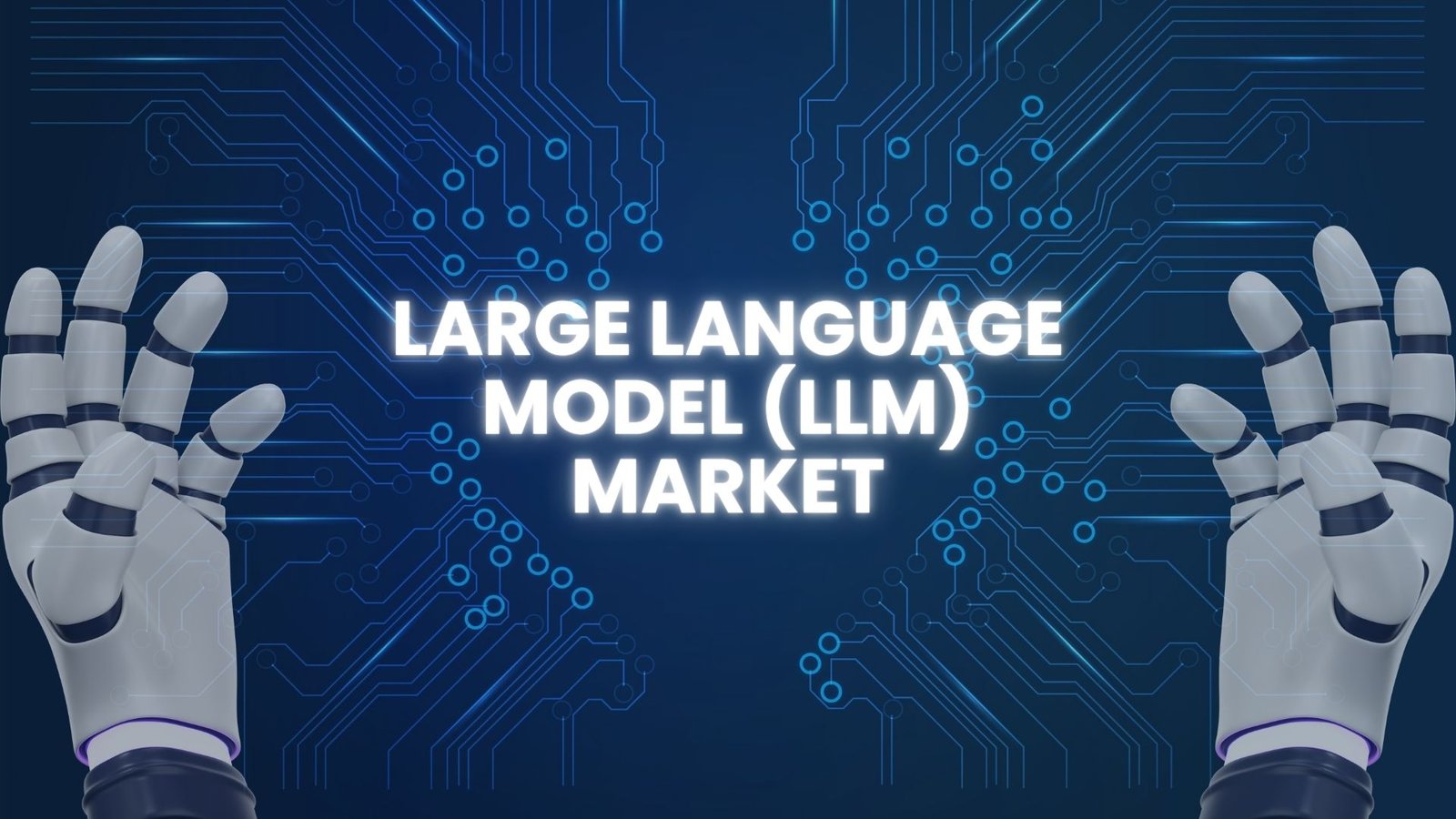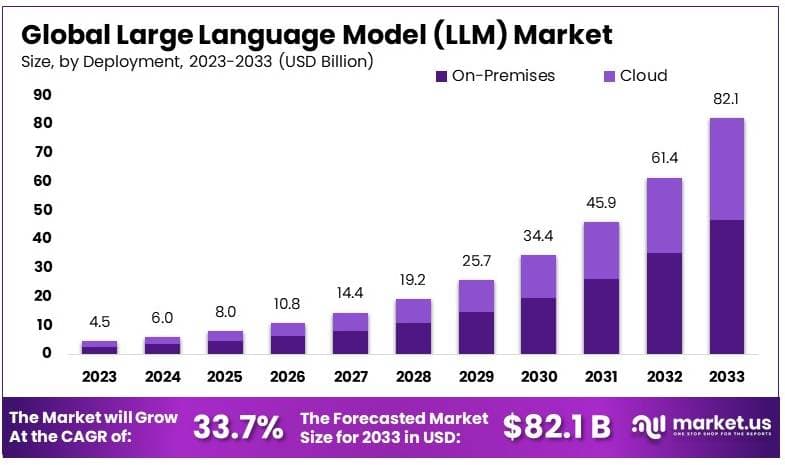Large Language Model (LLM) Market to Hit Nearly USD 82.1 Bn by 2033
Updated · Oct 31, 2025

WHAT WE HAVE ON THIS PAGE
Introduction
The Global Large Language Model (LLM) Market is projected to reach USD 82.1 billion by 2033, rising from USD 4.5 billion in 2023, at a CAGR of 33.7% between 2024 and 2033. The market’s growth is driven by the increasing adoption of generative AI systems for automation, analytics, and software development. GPT-4, capable of processing up to 1 million tokens, exemplifies this versatility, supporting applications from customer service automation to code generation.
Adoption of LLMs is expanding rapidly, with 67% of organizations now deploying generative AI products powered by these models. In financial services, for instance, 60% of Bank of America’s clients leverage LLM-based solutions for investment and retirement planning, reflecting the growing integration of AI into core business functions.
This trend underscores LLMs’ transformative impact on decision-making and operational efficiency across industries. Moreover, smaller models like Microsoft’s PHI-2 with 2.7 billion parameters are gaining traction by outperforming larger counterparts such as Llama-2 in coding tasks, demonstrating that optimized models can deliver high performance with greater efficiency and lower computational demands.

The Large Language Model (LLM) market is growing rapidly as these advanced AI models become essential tools for various industries. LLMs can understand and generate human-like text, helping businesses automate tasks like content creation, customer support, and data analysis. This technology is transforming sectors including banking, healthcare, and IT, where the need for natural language understanding is ever-increasing. The steady rise in digital content and demand for efficient language processing solutions are key reasons behind this surge, with over 30% growth rates reported recently. As organizations seek more personalized and scalable digital experiences, LLMs are becoming core to their transformation efforts.
Several top driving factors fuel the LLM market’s expansion. One major factor is the ongoing improvements in machine learning algorithms and computational power, which allow models to handle larger datasets and deliver more precise results. The growing availability of vast datasets for training contributes significantly to better model accuracy. Another crucial element is the escalating demand for automation across business functions to enhance operational efficiency and reduce human error. Additionally, industries are pushing for more domain-specific language models that can deliver expert-level knowledge in specialized fields, supporting higher adoption rates.
Key Takeaways
- The Global Large Language Model (LLM) Market was valued at USD 4.5 billion in 2023 and is projected to reach USD 82.1 billion by 2033, growing at an impressive CAGR of 33.7%.
- In 2023, On-Premises deployment led with a 57.7% share, driven by enterprise focus on data privacy, security, and regulatory compliance.
- The Chatbots and Virtual Assistants segment accounted for 27.1%, reflecting widespread adoption for automated customer support and conversational AI.
- By industry vertical, Retail and E-Commerce dominated with 27.5%, underscoring the role of AI in personalized shopping and real-time recommendation engines.
- North America held a 32.7% market share, supported by advanced AI R&D infrastructure, strong cloud ecosystems, and major LLM developers.
Large Language Models (LLMs) Statistics
- Definition and scale: Large Language Models (LLMs) are defined as AI systems containing at least 1 billion parameters, trained on massive datasets often spanning petabytes of text, code, and multimedia data to enable contextual and generative understanding.
- Market concentration: In 2023, the top five LLM developers collectively captured about 88.22% of global market revenue, indicating a highly consolidated market dominated by leading AI firms.
- Application expansion: By 2025, it is projected that 750 million applications will integrate LLM capabilities, signaling a major acceleration in AI-enabled software adoption across industries.
- Automation potential: By 2025, nearly 50% of digital work is expected to be automated using tools and workflows built on LLM technology, reshaping productivity and business operations.
- Enterprise adoption: Globally, among over 300 million companies, around 67% are already using generative AI tools powered by LLMs for content generation, automation, and decision support, according to Iopex.
- Experimentation phase: A Datanami survey (August 2023) revealed that 58% of companies are experimenting with LLMs, showing early adoption interest but indicating that large-scale operational integration is still developing.
Technological adoption is increasing with advancements enhancing the versatility and efficiency of LLMs. These models now integrate seamlessly with cloud computing and edge devices, allowing scalability and faster response times. The integration with multi-modal learning techniques enables models to process text alongside images and audio, broadening application horizons. Key reasons for adopting LLMs include reduced operational costs, improved accuracy in language understanding, and the ability to tailor solutions for specific business needs. Companies also value the ease of scaling LLM capabilities as their data and service demands grow.
Investment opportunities within the LLM sector are attracting significant attention from venture capital and established tech investors. Increasing corporate and government funding into AI research accelerates innovation in model architectures and applications. Investors see high potential for returns, considering that LLMs can optimize varied functions from legal compliance analysis to financial forecasting. Startups developing domain-specific LLM solutions or those improving model efficiency offer attractive prospects. Strategic partnerships between technology providers and end-user industries are also favorable for funding inflows.
The business benefits of LLM adoption are multifold. They streamline operations by automating repetitive and time-consuming text processing tasks, increasing workforce productivity. Organizations gain enhanced customer experience through faster and more context-aware interactions. LLMs also support innovation by providing actionable insights from large datasets, facilitating product development and marketing strategies. Many businesses report reduced error rates and improved decision quality. Overall, LLMs contribute to sustaining competitive advantage by enabling firms to react swiftly to market changes and customer needs.
Key Market Segments
By Deployment
- Cloud
- On-Premises
By Application
- Customer Service
- Content Generation
- Sentiment Analysis
- Code Generation
- Chatbots and Virtual Assistant
- Language Translation
By Industry Vertical
- Healthcare
- BFSI
- Retail and E-Commerce
- Media and Entertainment
- Others
Driver
Growing Demand for AI-Powered Automation
The demand for AI-driven automation is a major force fueling the growth of the Large Language Model market. Businesses across industries are increasingly adopting LLMs to automate tasks like content creation, customer service, and language translation. These models enhance productivity by handling large volumes of text data quickly and accurately, which is crucial for digital transformation efforts. The surge in digital content and the need for personalized customer interactions have made LLMs indispensable tools.
Additionally, adoption is boosted by advances in cloud computing and enhanced computational capacity, which enable scalable deployment of LLMs. Companies leverage these models to gain a competitive edge by improving decision-making, reducing operational costs, and creating smarter applications such as virtual assistants and chatbots. This driver is supported by a robust market growth forecast, with the global LLM market expected to expand at a compound annual growth rate above 30% over the next decade.
Restraint
High Computational Costs
One major restraint limiting the adoption of Large Language Models is the high cost of training and deploying these complex AI systems. LLMs require vast computing power and energy resources, translating into significant expenditures that can deter smaller companies and startups from integrating these solutions. The operating expenses include investment in specialized hardware like GPUs and ongoing costs associated with cloud services or data centers.
Furthermore, maintaining these models demands skilled professionals, which adds to the overall cost burden due to a limited talent pool in AI expertise. High computational costs not only hinder widespread adoption but also raise sustainability concerns, as the energy requirements contribute to environmental impacts. This restraint remains a key challenge for market growth despite the many advances in AI technology.
Opportunity
Expansion in Non-English Language Markets
A promising opportunity in the LLM market lies in developing models tailored for non-English languages. While most advanced LLMs currently focus on English, there is rising demand for models that understand and generate text in diverse languages to serve global markets. Addressing this gap can open new revenue streams by enabling applications in local languages for customer support, content creation, and natural language understanding.
This regional and linguistic expansion can drive adoption in emerging economies and underrepresented language groups, broadening the market reach substantially. Companies that invest in multilingual capabilities and domain-specific customization stand to gain a competitive advantage by tapping into underserved demographics and industries that generate high volumes of language-specific data, such as healthcare and legal services.
Challenge
Managing Bias and Ethical Concerns
A significant challenge for LLM developers is addressing biases embedded in training data and ensuring ethical usage. Since these models learn from vast datasets sourced from the internet and other media, they can inadvertently replicate or amplify societal biases, leading to unfair or harmful outputs. This can damage brand reputation and provoke regulatory scrutiny, especially in sensitive applications like hiring, lending, or law enforcement.
In addition, ethical concerns about misinformation, data privacy, and transparency complicate deployment and adoption. Organizations must invest in robust bias mitigation techniques and transparent model governance to build trust with users and regulators. Navigating these ethical and compliance issues while maintaining model performance remains a complex and ongoing challenge for the LLM market.
Source of Information – https://market.us/report/large-language-model-llm-market/
Sources

Rohan is a senior editor at Techno Trenz. He knows a lot about digital marketing, SEO, and social media optimization. Rohan is great at creating and editing detailed articles with accurate statistics that readers find useful. As a senior editor, he reviews and checks the quality of content from many writers before it is published. He also makes infographics to go with the statistics, making the information easier to understand and more engaging. Rohan's hard work ensures that Techno Trenz provides high-quality and informative content to its readers.









